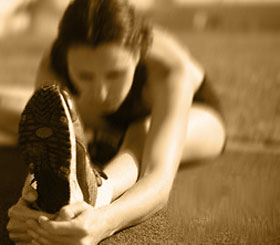Osteoporosis: A Disease of Young Athletes
Are you at Risk?
by Jennifer Malcolm
Although we typically associate osteoporosis with little old ladies, decreased bone mineral density (BMD) is becoming more and more common amongst the young running population. In fact, one article studying BMD in middle-aged runners found that 25-year-old amenorrheic runners (runners not having any menstrual cycles) had the bone mineral density of a 50-year-old woman. Thus, early onset of osteoporotic BMD has been strongly associated with menstrual irregularities.
During the teenage years, it may take a while for ovulation and menstruation to occur regularly. One article states that 95% of young girls skip about 90 days between periods during their first year of menstruation. However, some menstrual irregularities are not normal and are associated with serious life-long complications. Primary amenorrhea is the complete absence of one’s period at the age of 17+, while secondary amenorrhea is the absence of one’s period for 6+ months after the onset of menses. Such menstrual irregularities seem to be common in athletes that require a lean body physique, run an intense number of miles, etc. In fact, it has been suggested that over half of high school runners experience menstrual irregularities at some point in their running career.

This change in menstruation has a direct impact or is the result of a change in the normal cycle of hormones within the body. Estrogen rises and falls naturally with each woman’s menstrual cycle. Aside from the direct effects of estrogen on menstruation, it also acts as a bone protector and increases the cells (osteoblasts) that build bone. In short, estrogen helps stimulate bone growth. Extreme weight loss, reduced fat stores or repeated intense exercise can interfere with the normal variations of estrogen along with other hormones involved in the menstrual cycle. Low levels of estrogen therefore prevent normal bone growth.
It has been proven that peak bone mass is attained during the teenage years. If hormone abnormalities are present during this stage of growth, peak bone mass will be much lower than in the average woman. During the late 20s, women begin to slowly loose bone mass despite diet modifications and other attempts to maintain their peak BMD. As we age, this process accelerates. For those individuals starting this decline at a lower peak BMD than the average woman, osteopenic or osteoporotic BMD will be achieved at a much younger age. Thus, hormonal abnormalities predispose individuals to early onset of osteoporosis.
Osteoporosis is often referred to as “the fragile bone disease” or “thinning of bone”. Osteopenia is considered 1.5-2.5 standard deviations below the normal BMD and osteoporosis is 2.5+ standard deviations below the normal BMD. Osteoporosis is characterized by a loss of bone mass due to a decrease in bone minerals such as calcium, vitamin D and magnesium. The tendency to develop fractures is directly correlated with low BMD. This disease is therefore associated with severe pain, an increased number of fractures, and wedging of vertebrae causing a loss of height and hunched back. Such changes are considered permanent, so the best treatment is prevention.
Diet and weight bearing exercises, maintenance of normal menstrual cycles, along with the avoidance of smoking and excessive alcohol consumption are the best ways of maintaining healthy bone mass. Yes…weight-bearing exercise is considered preventative. Such exercises have been proven to increase bone mineral density to a point. Once exercise progresses to a level of excess or a level that changes the body’s normal physiology (i.e. menstrual irregularities), it has the reverse effect. It is therefore critical for runners to understand that the absence of menstruation is not normal. The absence of one’s period can be considered a warning sign for the life-long effects that vigorous exercise can have on one’s body.
Still, if a female’s menstrual cycle returns because that individual increased caloric/mineral intake or decreased mileage/intensity of training, it cannot simply be assumed that BMD has returned to normal. A bone densitometry scan (DEXA scan) may be necessary to assess BMD in such patients to truly determine the amount of bone damage. If you have been experiencing a loss of menses or have undergone multiple stress fractures from running, the issue should be discussed with your physician.
During the 2008 cross country season, Dr. Chris Mehallo of The Rothman Institute of Orthopedics, Ryan Savtiz and Jennifer Malcolm are conducting a study on menstrual irregularities in high school runners. This study will serve to benefit the female high school running community since this issue can be a lifelong problem in some athletes. If you would be willing to participate in our survey study we would greatly appreciate it. The study is purely voluntary. It involves completing an online survey during the cross country preseason (or the first two weeks of the cross country season). This survey will only take 10-15 minutes of your time and is only filled out once. Then, during the months of August through November, we ask that you complete an online menstrual log. The log takes less than five minutes to fill out. All information is strictly confidential. Your name and your team’s name will not be recorded anywhere on the survey, so your answers will be impossible to trace back to you. Also, it is not necessary to have experienced menstrual irregularities to participate in this study. All female high school cross country runners are welcomed into the study. If you are interested in participating, think your team is interested or simply have questions, please email me at
[email protected] or Christopher Mehallo, DO at
[email protected]. Thank you for your interest.